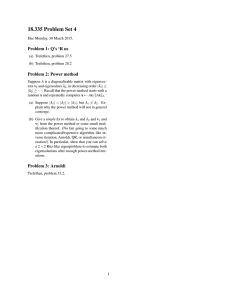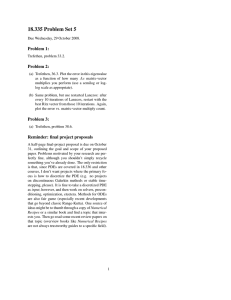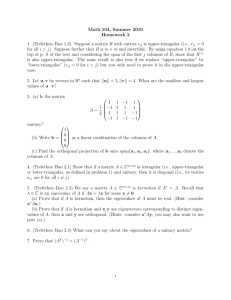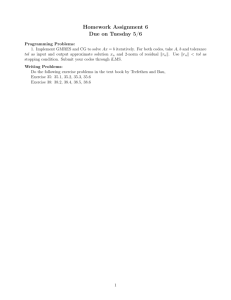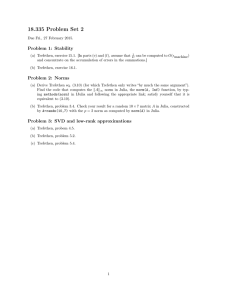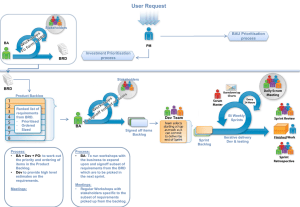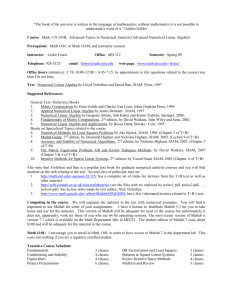Solutions - Per
advertisement
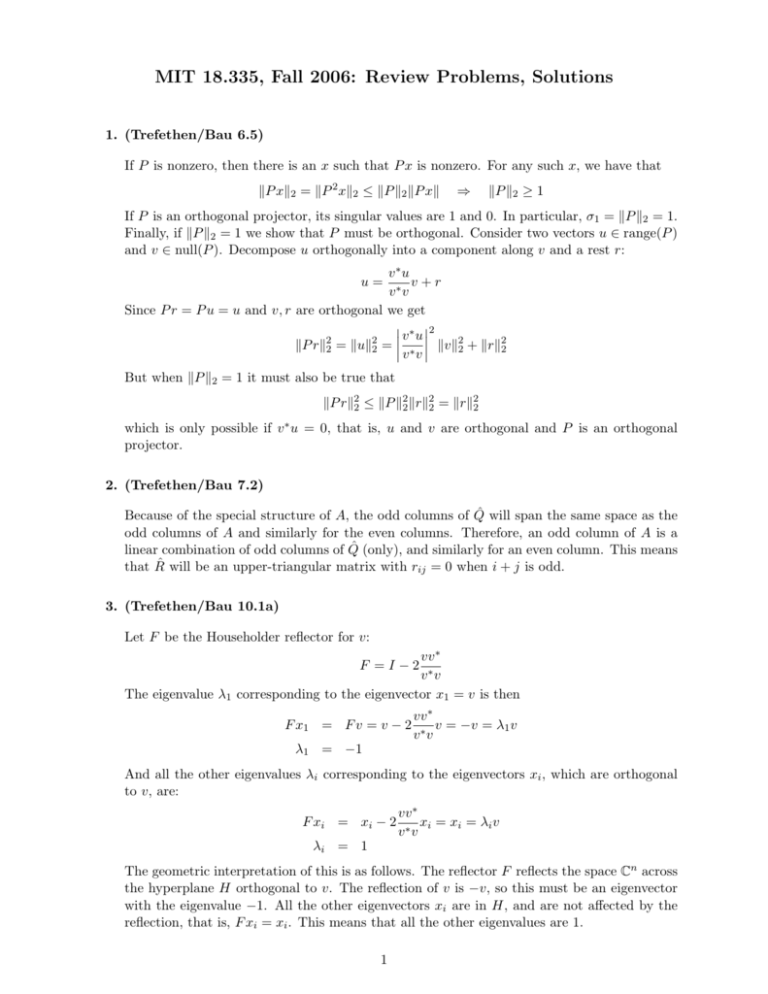
MIT 18.335, Fall 2006: Review Problems, Solutions 1. (Trefethen/Bau 6.5) If P is nonzero, then there is an x such that P x is nonzero. For any such x, we have that kP xk2 = kP 2 xk2 ≤ kP k2 kP xk ⇒ kP k2 ≥ 1 If P is an orthogonal projector, its singular values are 1 and 0. In particular, σ1 = kP k2 = 1. Finally, if kP k2 = 1 we show that P must be orthogonal. Consider two vectors u ∈ range(P ) and v ∈ null(P ). Decompose u orthogonally into a component along v and a rest r: v∗u v+r v∗ v Since P r = P u = u and v, r are orthogonal we get ∗ 2 v u 2 2 kP rk2 = kuk2 = ∗ kvk22 + krk22 v v u= But when kP k2 = 1 it must also be true that kP rk22 ≤ kP k22 krk22 = krk22 which is only possible if v ∗ u = 0, that is, u and v are orthogonal and P is an orthogonal projector. 2. (Trefethen/Bau 7.2) Because of the special structure of A, the odd columns of Q̂ will span the same space as the odd columns of A and similarly for the even columns. Therefore, an odd column of A is a linear combination of odd columns of Q̂ (only), and similarly for an even column. This means that R̂ will be an upper-triangular matrix with rij = 0 when i + j is odd. 3. (Trefethen/Bau 10.1a) Let F be the Householder reflector for v: vv ∗ v∗v The eigenvalue λ1 corresponding to the eigenvector x1 = v is then F =I −2 F x1 = F v = v − 2 vv ∗ v = −v = λ1 v v∗v λ1 = −1 And all the other eigenvalues λi corresponding to the eigenvectors xi , which are orthogonal to v, are: F xi = xi − 2 vv ∗ xi = xi = λi v v∗v λi = 1 The geometric interpretation of this is as follows. The reflector F reflects the space Cn across the hyperplane H orthogonal to v. The reflection of v is −v, so this must be an eigenvector with the eigenvalue −1. All the other eigenvectors xi are in H, and are not affected by the reflection, that is, F xi = xi . This means that all the other eigenvalues are 1. 1 (Trefethen/Bau 10.1b) det(F ) = n Y λi (F ) = −1 i=1 (Trefethen/Bau 10.1c) The singular values of F are the eigenvalues of F ∗ F : vv ∗ vv ∗ ∗ I −2 ∗ F ∗F = I −2 ∗ v v v v ∗ ∗ ∗ vv vv vv =I = I −4 ∗ +4 v v (v ∗ v)2 which are all 1. 4. (Trefethen/Bau 15.1e) First, we note from the Taylor expansion of ex that in exact arithmetic, if n terms are included P∞ in the sum, the terms neglected k=n+1 1/k! are bounded by O(machine ). Also, since there are no inputs x to this problem, we can not have backward stability unless f˜ = f , which is impossible since f = e. Instead we consider the forward error |f˜ − f | to determine if the algorithm is stable or unstable. The factorial 1/k! can be computed with a relative accuracy of 2kmachine + O(2machine ), since it has k roundings to floating points, k − 1 floating point multiplications, and 1 floating point division. Now, the sum f˜ computed from the left can be written (neglecting second order terms) 1 1 1 ··· (1 + 2 · 0 · 1 ) + (1 + 2 · 1 · 2 ) (1 + 3 ) + (1 + 2 · 2 · 4 ) (1 + 5 ) · · · 0! 1! 2! where |i | ≤ machine . The largest error is obtained if all i = machine , in which case the coefficient a1 for all first powers of machine is: n k−1 X X 2k + 1 1 a1 = + k! j! j=0 k=0 But this coefficient grows with increasing number of terms n, a simple lower bound is: n X 1 a1 ≥ =n 0! k=1 Therefore, since n grows with decreasing machine , the error cannot be bounded as O(machine ) and the algorithm is unstable. (Trefethen/Bau 15.1f ) In this case, the algorithm computes 1 1 1 (1 + 2n1 ) + (1 + 2(n − 1)2 ) (1 + 3 ) + (1 + 2(n − 2)4 ) (1 + 5 ) · · · ··· n! (n − 1)! (n − 2)! 2 and the coefficient a1 for all first powers of i becomes n k−1 X X 2(n − k) + 1 1 a1 = + (n − k)! (n − j)! j=0 k=0 This time, the coefficient can be bounded from above independently of n: n n n n−1 n X X X X X n−k 1 n−k 1 1 a1 = 2 + + =3 + ≤ 4e (n − k)! (n − k)! (n − k)! (n − k − 1)! (n − k)! k=0 k=0 k=0 k=0 k=0 Therefore, the total relative error is bounded by O(machine ), and the algorithm is stable. 5. (Trefethen/Bau 21.3) 1. Since A is nonsingular, it must have some nonzero entry in row 1, let’s say in column j. Let Q1 swap columns 1 and j. The upper left element of AQ1 will then be nonzero, and one step of Gaussian elimination can be performed. The upper left element of U will then also be nonzero, and the lower right (m−1)×(m−1) submatrix will be nonsingular just like A. This process can be applied recursively to this submatrix, and with the same syntax as in the book, the matrix is factorized as Lm−1 · · · L2 L1 AQ1 Q2 · · · Qm−1 = U or, equivalently, with Q = Q1 Q2 · · · Qm−1 and L = (Lm−1 · · · L2 L1 )−1 , AQ = LU 2. If A is singular, it is not always possible to change columns so that the upper left element of the matrix is nonzero. The algorithm will then break down, and the matrix cannot be factorized in the form AQ = LU . An example is the matrix 0 0 A= 1 1 The columns are equal, so AQ = A. But this cannot be factorized as LU , since u11 u12 u11 u12 1 0 0 0 = = l21 u11 l21 u12 + u22 l21 1 0 u22 1 1 Solving gives that u11 = 0, but then it is not possible to have l21 u11 = 1. Therefore, there is no factorization AQ = LU . 3
